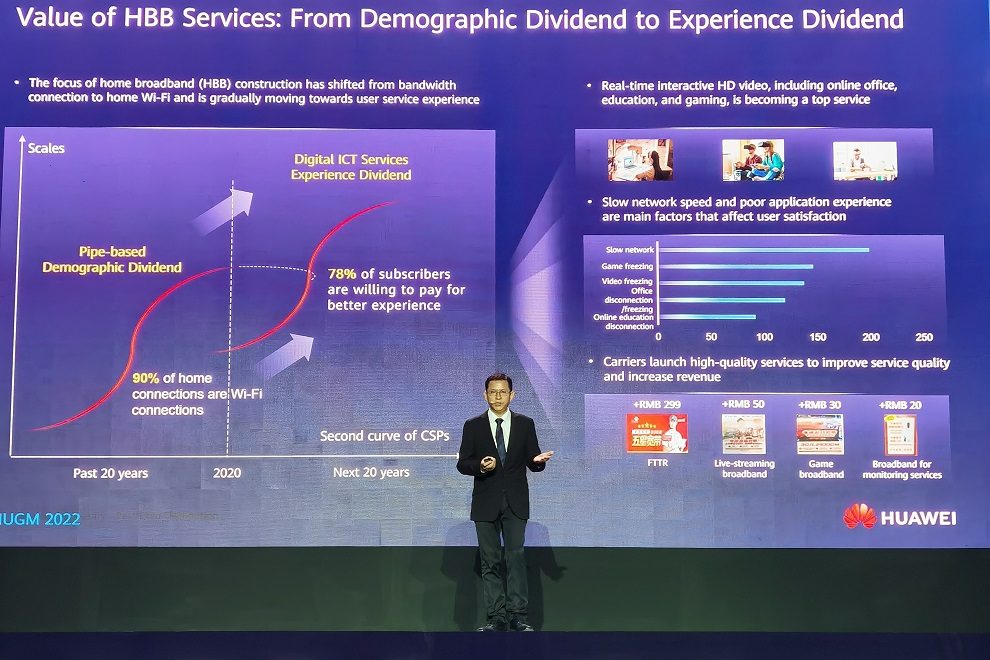The 14th Huawei User Group Meeting was held in Bangkok, Thailand, where Huawei and global industry leaders, carriers, and partners, discussed core topics related to the network industry and demonstrated future-oriented digital technology innovations. During the meeting, Wang Jinping, Marketing Director of Huawei NCE Optical Network Domain, delivered a keynote speech. Wang Jinping said that the value of home broadband (HBB) services is evolving from demographic dividends to experience dividends. Huawei’s Premium Broadband solution can effectively help carriers to implement user experience operations, seize business growth opportunities and provide users with quality experience.
Over the past 20 years, HBB services have been rapidly developing around the world. However, users have high requirements for premium HBB experience. Nowadays, real-time interactive HD video services, such as online office and online education, are important to users. Application experience has become key to ensuring user satisfaction, and users want a better network experience even if it comes at a higher cost. In a situation where experience dividends emerge massively, carriers around the world are looking to evolve from providing assurance for broadband connections to delivering the best application experience.
Wang Jinping also mentioned that in line with the new trend, carriers should develop HBB services from the following three aspects:
➢ To meet the requirements of various services and the huge potential user market, apply intelligent technologies to improve the accuracy of identifying potential users and increase the marketing success rate, thus quickly gaining market share.
➢ Ensure the device-network-service matching, construct networks based on user experience requirements, and maximize the return on investment (ROI).
➢ Build capabilities that help perceive user experience to improve HBB user experience and user satisfaction, thereby improving brand reputation and achieving service growth.
To help carriers realize these goals, Huawei launched the Premium Broadband solution outside China for the first time. In this solution, intelligent AEC boards are installed on OLTs to collect application KPIs such as delay and jitter in real time so that user experience can be accurately and effectively perceived. In addition, the collaboration between iMaster NCE (a management, control, and analysis system which provides the big data intelligent analysis capability) and Agile Digital Operations (ADO) helps carriers gain dividends from HBB user experience operations.
Insights into Experience Requirements, Facilitating Marketing Growth
The solution provides more than 100 experience labels in four dimensions: application, user experience, bottleneck, and networking. These labels facilitate the capturing of key information in the user experience dimension, such as application type, experience quality, experience
bottleneck, and Wi-Fi coverage. In this way, the potential user identification model is optimized from being single-dimensional to being multidimensional, helping carriers more accurately, intuitively, and comprehensively perceive user experience requirements. Accordingly, the marketing department can formulate more accurate, effective, and detailed marketing strategies based on the captured information to meet user requirements and get a head start in the market.
Device-Network-Service Matching, Facilitating Orderly Network Upgrades
Substandard user experience may result from incorrect device-networks-service matching. To address this issue, the traffic statistics collection function provided by the solution was upgraded from minutes-level to seconds-level. In addition, the peak-to-average ratio (PAR) traffic model was introduced into the fixed network domain. Based on PAR big data, this model analyzes capacity expansion thresholds to ensure accurate network-service mapping. The innovative triangular suppression model identifies user experience bottlenecks from three perspectives: real user experience (such as poor-QoE experience and poor-QoE duration percentage), PON port congestion, and ONT congestion. In this way, carriers can further ensure the correctness of devicenetwork-service mapping, upgrade networks in an orderly manner, and provide basic assurance for high-quality HBB connections and optimal experience.
Minutes-level Experience Perception, Improving Passive Responses to Proactive Services
Service experience is the cornerstone of brand reputation and sustainable business development for carriers. Based on this concept, the Premium Broadband solution integrates the upgraded perception capability, which is improved from the Wi-Fi connection dimension to the user experience dimension, implementing minutes-level perception of poor-QoE issues (such as video freezing) and generating poor-QoE snapshots. As a result, carriers can accurately identify poorQoE causes in time and space dimensions and proactively perform network optimization. In this way, the solution helps carriers change the passive perception mode based on user complaints to the brand-new proactive experience perception and assurance mode to effectively reduce user complaints and improve the brand reputation, thereby helping carriers improve the user retention rate and user satisfaction.
Currently, the Premium Broadband solution has been commercially deployed at about 50 sites in China. In Henan, the five-dimension model of insights into experience data increased the marketing success rate of FTTR and gigabit services from 3% to 10%. Furthermore, on-demand
network construction based on the triangular suppression model improved the network ROI by 40%. In Zhejiang, accurate poor-QoE analysis results and the proactive rectification function decreased the poor-QoE rate from 4.3% to 2.7% and decreased complaints per 10,000 users from 165 to 95. As a result, user satisfaction of the carrier exceeds that of its competitors, enabling the carrier to realize competitiveness in all aspects.
According to Wang Jinping, HBB user experience operations require further collaboration between Huawei and carriers. Through solution enablement and joint verification of best practices, user experience operations will truly facilitate development, further broaden business boundaries, and expand the dividend pattern.












